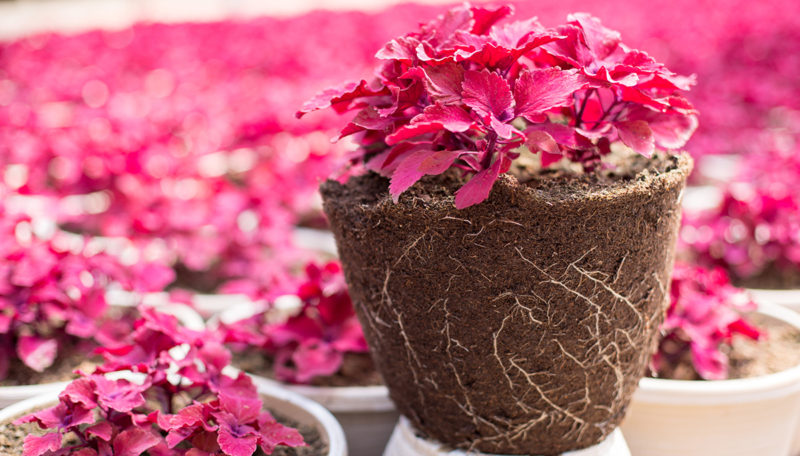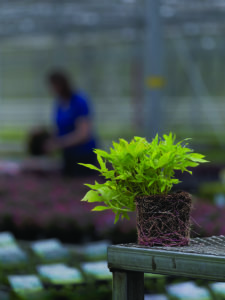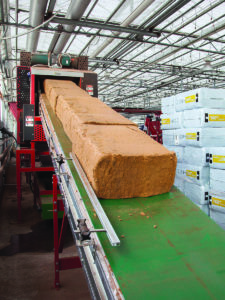
Adding Innovation to the Mix
Jasmina Dolce: What is HydraFiber and what makes it unique compared to other growing media?
Daniel Norden: HydraFiber is an approximately 98% porous fiber substrate with extremely low bulk density. What makes HydraFiber unique is that it’s manufactured with our patented Thermally Refined process that combines wood and bark chips and refines them in a pressurized vessel to create singulated, small-diameter, long, thin strands with large surface area. By going through a couple rounds of heat and pressure, the wood and bark chips are sterilized and become more stable. The end result is a fiber that has a tremendous amount of
surface area, which gives it a very high total porosity and a consistency that growers appreciate.
JD: What are the benefits to using HydraFiber versus a typical soilless
mix?
 DN: We know growers previously faced the challenge of finding a mix that is well aerated for production but is also capable of holding enough water that the plant will look good at the store. Because HydraFiber has very high total porosity, the substrate adds air space to the mix to achieve a well-aerated product compared to other substrates, but it doesn’t sacrifice water-holding capacity. We like to think of it as allowing growers to have their cake and eat it, too.
DN: We know growers previously faced the challenge of finding a mix that is well aerated for production but is also capable of holding enough water that the plant will look good at the store. Because HydraFiber has very high total porosity, the substrate adds air space to the mix to achieve a well-aerated product compared to other substrates, but it doesn’t sacrifice water-holding capacity. We like to think of it as allowing growers to have their cake and eat it, too.
Another major benefit is that HydraFiber is available 24/7/365. Because it is an engineered, manufactured and renewable product, growers can order HydraFiber when they need it knowing they will receive just-in-time delivery always with the same high-quality product they expect. What we make today is the same as what we’ll make tomorrow, next year and 10 years from now.
JD: How does HydraFiber handle nitrogen tie up?
DN: We have done testing with numerous independent organizations and universities to better understand this phenomenon as it relates to HydraFiber. The general consensus of these groups, combined with grower trials, is that growers can safely use up to 50% HydraFiber in the mix without changing the fertility practices that they are already using. Any organically derived raw material will always have some degree of nitrogen tie up. The difference with HydraFiber is we understand from our 50 years of experience refining wood how to refine the wood to stabilize it and eliminate many of the compounds that mimic the effects of nitrogen tie up.
JD: What is the nutrient storage like?
DN: HydraFiber has a low cation-exchange capacity (CEC), as is common with most soilless substrate raw materials relative to field soils. As a result, growers have adapted to growing in substrates with low CEC and understand what it will take to replenish nutrition in their production practices. We’ve learned that this is particularly important in terms of substrate pH buffering. Relative to peat moss, HydraFiber has a much lower CEC, and even though they have similar pH values, the pH buffering of HydraFiber is lower, meaning you can more easily change the pH up or down as a result. As growers are working with HydraFiber, we talk to them about the importance of understanding this practice. That’s why we work with growers to make recommendations on lime rate because growers generally need to reduce the lime rate when using HydraFiber.
JD: Does this work well coast to coast, considering water quality differences?
DN: We know water quality is critical, and our technical staff always encourages growers to conduct routine water audits so we can assist with making substrate and growing recommendations. Water alkalinity (water pH buffering or ability of water to neutralize acid), in particular, is an important aspect for growers to be aware of when they have their water tested, and HydraFiber technical experts can help growers adjust their lime rates based on their water alkalinity.
Specifically when it comes to water quality, HydraFiber’s low CEC is actually a benefit for growers with poor water quality because HydraFiber is virtually inert and will not bind cations compared to coir or peat. It is also nutrient poor, which is good for growers because there are no nutritional surprises. For example, growers don’t need to worry about injuriously high levels of potassium or sodium in their HydraFiber mixes.
JD: Can you tell me about the aeration aspects?
DN: HydraFiber’s high total porosity means it has the potential to add a lot of air space for the plants, providing a more forgiving mix for growers. Mixes that have very good air space often have well-oxygenated root zones, which correlates with good root development. This was very important to our team as we worked to develop the product. It’s the reason we offer five different products in our Ultra line with varying degrees of coarseness, so growers can achieve the aeration level that will work best for their plants.
JD: Let’s discuss water retention. If lower amounts of water are retained, can growers adjust nutrition more quickly?
DN: Yes, if the grower needs to feed more frequently, we’d recommend using HydraFiber Ultra 365 or 510 because these formulations can add more air space to the mix. Growers may find they have crops that need more water holding, so they use HydraFiber Ultra 065. HydraFiber provides from 10 to 36% more readily available water to every plant. The water is mostly held on the surface of the fibers, which makes it easy for the roots to extract water. Our product line has fine to super coarse fibers that allow growers to be in the driver’s seat when it comes to determining their water-holding capacity.
JD: How does it change traditional crop timing?
DN: Several of our growers say they have been able to shorten their crop time by using HydraFiber. In order to do so, growers need to understand that there are some learning curves with irrigation management. Most growers find they need to irrigate less. By overwatering, growers can inhibit root performance because oxygen isn’t getting into the root zone, which will have a direct effect on crop timing. We encourage growers to pick up the pots and look at the root balls to
determine if and when they need to water.
JD: Is this a sustainable product? Are there any environmental benefits?
DN: HydraFiber’s bark chips are a byproduct of the lumber industry. We are able  to divert those resources from the waste stream and productively reintroduce them into the environment in our sustainable products. We also source our material within a 75-mile radius of our plant in Conover, North Carolina, thus reducing our carbon footprint to ship in materials.
to divert those resources from the waste stream and productively reintroduce them into the environment in our sustainable products. We also source our material within a 75-mile radius of our plant in Conover, North Carolina, thus reducing our carbon footprint to ship in materials.
Growers who use HydraFiber are also able to see environmental benefits in their own production. Because it is highly compressed, growers are able to reduce the number of truckloads it takes to receive the same amount of product compared to other growing media. For instance, one semi of HydraFiber Ultra is equal to the same amount of material as two truckloads of coir, five truckloads of peat and eight truckloads of perlite.
JD: What can growers expect in terms of business efficiencies?
DN: Our motto is “Grow Better Margins & Better Plants” because we believe growers should be able to achieve the best plant quality without sacrificing on their budgets. Growers tell us HydraFiber is predictable and consistent. Because HydraFiber is highly compressed, it can be easily stored, and growers can save money because they don’t need to order shipments as often. Plus, the supply and pricing is consistent, unlike other raw materials where supply and price can fluctuate. Growers also tell us HydraFiber has improved the overall work environment by eliminating the dust workers normally experience with perlite.
JD: What is next for HydraFiber?
DN: We strongly feel substrates are an area that hasn’t seen a lot of change over the last 25 years, and we are proud to be on the frontier of innovation. This year, HydraFiber introduced two new products, EZ Blend and Hybrid, to the market. These products are designed for the grower that wants to enjoy the benefits of HydraFiber without adding specialized processing equipment to their lines. HydraFiber Hybrid is for blenders or growers who have a bale buster or shaver in their line for mixing soils. EZ Blend is best for growers who pad mix their soils. As these products gain traction, we’re confident more growers will be able to see the benefits of working with HydraFiber. No matter what size operation growers have, there is a HydraFiber solution for you.
As we look into the future, we’re actively pursuing new ways of solving the biggest problems growers are experiencing with their mixes. We understand that some growers may be reluctant to change, but we are committed to this industry, and we believe HydraFiber is the future. As more customers raise environmental concerns and as other raw materials face supply issues, we strongly believe HydraFiber is the most logical option for growers.


 Video Library
Video Library 




















